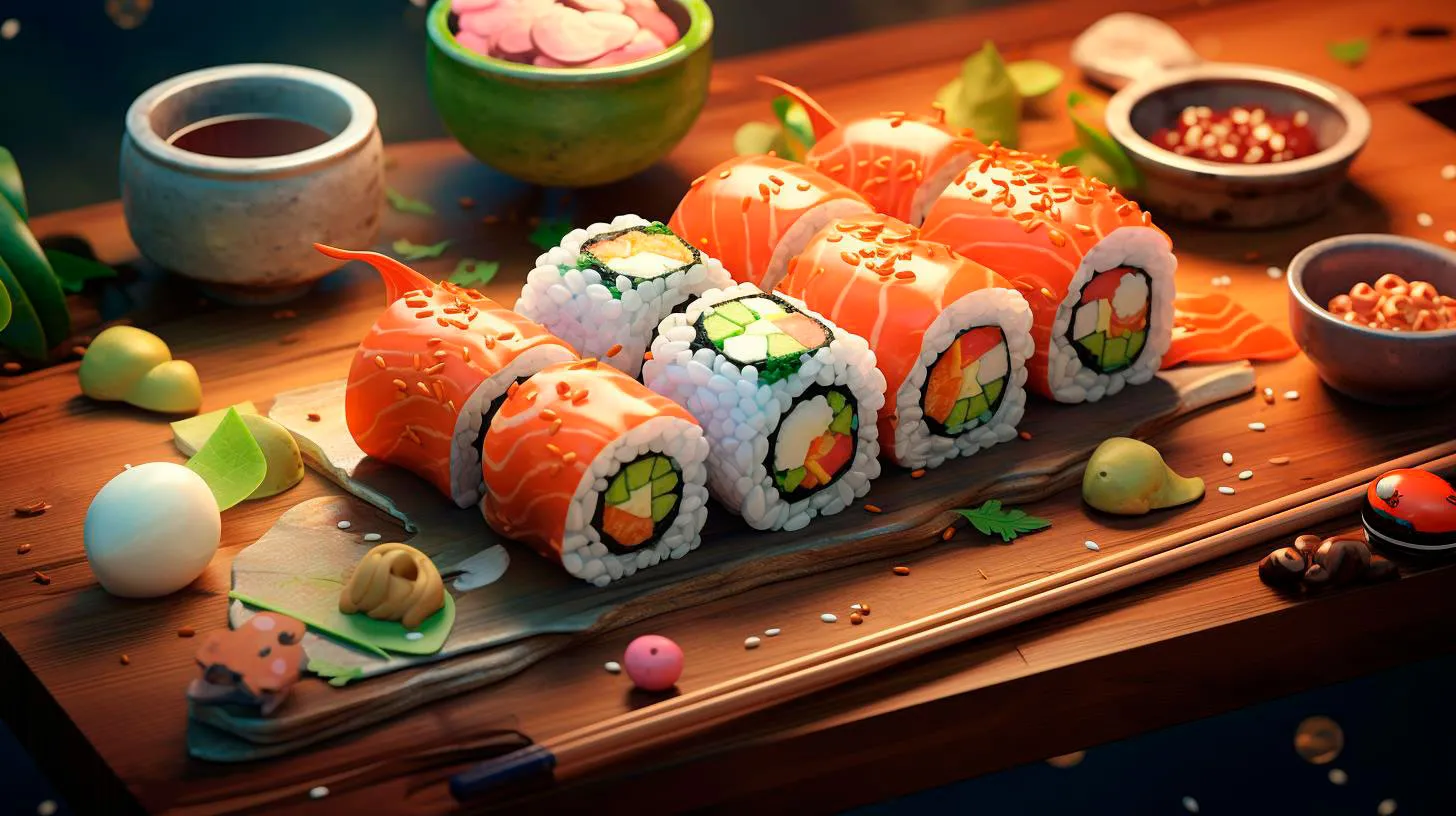Traditional Sushi Ingredients in Japan: The Key Elements
The Rice: The Heart and Soul of Sushi
At the heart of every sushi roll lies the rice. Sushi rice, also known as shari or sumeshi, is the key ingredient that holds the entire dish together. This short-grain rice is cooked using a specific method that ensures it retains its stickiness while also allowing it to maintain its individual grain texture. The rice is seasoned with a mixture of rice vinegar, sugar, and salt, giving it a distinctive tangy flavor that perfectly complements the other ingredients.
Key takeaways:
- Sushi rice is short-grain rice that is sticky in texture.
- It is seasoned with a mixture of rice vinegar, sugar, and salt.
- The proper cooking method ensures the rice maintains its individual grain texture.
- Quality sushi rice is essential for a great sushi experience.
Fillings: The Variety of Seafood and Beyond
While seafood is often the star of the show when it comes to sushi fillings, there is an incredible variety of options to choose from. Traditional sushi ingredients include fresh slices of fish such as tuna, salmon, yellowtail, and mackerel. These fishes go through a meticulous process of selection, preparation, and slicing to ensure the utmost freshness and flavor. Apart from seafood, sushi can also be filled with vegetables, tofu, or even egg. The creativity and diversity of fillings make sushi a delightful choice for everyone, regardless of dietary preferences.
Key takeaways:
- Traditional sushi fillings primarily consist of fresh slices of fish.
- High-quality and fresh seafood is crucial for a superior sushi experience.
- Vegetables, tofu, and egg can also be used as sushi fillings, catering to diverse dietary preferences.
- Sushi offers a wide variety of options to suit different tastes and preferences.
Nori: The Wrapping Agent
One cannot underestimate the importance of nori in sushi. This edible seaweed forms the outer layer that holds the rice and fillings together. It provides a subtle umami flavor that balances the tanginess of the rice and enhances the overall taste. Nori is usually harvested from specific coastal regions in Japan and undergoes a meticulous process of drying and roasting before it is ready to be used. Its crisp texture and unique taste add another layer of delight to every sushi roll.
Key takeaways:
- Nori is an edible seaweed that wraps around the sushi roll.
- It provides a delicate umami flavor and adds texture to the dish.
- High-quality nori is sourced from specific coastal regions in Japan.
- The drying and roasting process enhances the taste and texture of the nori.
Soy Sauce and Wasabi: The Perfect Complement
No sushi experience is complete without the accompaniments of soy sauce and wasabi. Soy sauce, made from fermented soybeans, lends a salty and savory flavor that complements the delicate flavors of the sushi. Wasabi, often mixed with soy sauce, adds a spicy kick that intensifies the overall taste. Used in moderation, these condiments enhance the sushi experience by adding depth and complexity to the flavors.
Key takeaways:
- Soy sauce accompanies sushi and provides a salty, savory flavor.
- Wasabi adds a spicy kick, enhancing the overall taste.
- Used in moderation, soy sauce and wasabi deepen the flavors of sushi.
- The right balance of condiments provides a well-rounded sushi experience.
Cultural Significance and Ongoing Evolution
Sushi is not just a dish; it represents a rich cultural heritage that has been passed down through generations. The precise technique, attention to detail, and respect for ingredients are deeply ingrained in the art of sushi making. While traditional sushi ingredients remain unchanged, sushi has also evolved over time to cater to modern tastes and preferences. The fusion of flavors and innovative presentation styles have made sushi a global sensation, appreciated by people from all corners of the world.
Key takeaways:
- Sushi carries immense cultural significance in Japan.
- Sushi making involves precise techniques, attention to detail, and respect for ingredients.
- Traditional sushi ingredients have stood the test of time but have also evolved to cater to modern tastes.
- Sushi’s fusion flavors and innovative presentation styles have contributed to its global popularity.
In conclusion, sushi represents the epitome of Japanese cuisine, with its unique blend of flavors, textures, and cultural significance. From the sticky and tangy rice to the fresh and carefully selected fillings, each ingredient plays an integral role in the overall sushi experience. By understanding the key elements that make up traditional sushi, one can truly appreciate the craftsmanship and artistry involved in creating this beloved culinary delight.
Umami Universe: Shared Flavors in Japanese and Western Sushi
The Umami Sensation
Umami, often referred to as the “fifth taste,” is a savory and rich flavor that adds depth to various dishes. It was first discovered by Japanese chemist Kikunae Ikeda in 1908, but its influence has resonated across the globe.
Umami is derived from glutamate, an amino acid present in certain foods like soy sauce, mushrooms, and seaweed. It stimulates our taste buds, creating a pleasant and satisfying eating experience. This flavor profile has played a significant role in the evolution of sushi, both in Japan and the Western world.
Traditional Japanese Sushi
Japanese sushi is a time-honored culinary tradition that showcases the delicate balance of flavors, textures, and presentation. Here are some key points that define traditional Japanese sushi:
- Freshness: Traditional sushi emphasizes the use of the freshest ingredients, especially raw fish like tuna, salmon, and mackerel. The quality and freshness of the fish are paramount.
- Simplicity: Japanese sushi focuses on the natural flavors of the ingredients. Sushi chefs often use minimal seasoning, ensuring that the ingredients speak for themselves.
- Types: In Japan, sushi comes in various forms – nigiri, maki, sashimi, and more. Each has its unique preparation and presentation style.
These key characteristics of Japanese sushi highlight the appreciation for simplicity, quality ingredients, and the pursuit of harmony in flavors.
Western Sushi: A Fusion of Cultures
When sushi made its way to the Western world, it underwent various adaptations to suit local tastes and ingredients. Western sushi takes inspiration from traditional Japanese sushi but adds its own twist, resulting in a fusion of flavors. Here are some distinguishing features of Western sushi:
- Creativity: Western sushi chefs often experiment with different ingredients, flavors, and presentations. This creativity has led to the invention of unique sushi rolls and combinations that appeal to a wider audience.
- Avocado and Cream Cheese: These ingredients, although not traditional in Japanese sushi, have become popular additions in Western sushi rolls. They add a creamy texture and subtle flavors that complement other ingredients.
- Sauces and Condiments: Western sushi commonly incorporates sauces like spicy mayo, eel sauce, and soy-based dressings. These enhance the overall taste profile and add an extra kick of flavor.
Western sushi embraces the innovative spirit of fusion cuisine, combining traditional Japanese techniques with local ingredients and preferences.
Key Takeaways
As we explore the world of sushi, it’s fascinating to witness the convergence of Japanese and Western culinary traditions, all united by the presence of umami. Here are some key takeaways to remember:
- Umami: Both traditional Japanese sushi and Western sushi rely on umami-rich ingredients to create a delicious flavor experience.
- Appreciation for Tradition: Japanese sushi emphasizes simplicity, freshness, and harmony in flavors, while Western sushi adds a creative touch while respecting the roots of the cuisine.
- Fusion Cuisine: Western sushi showcases the fusion of cultures by incorporating local ingredients and flavors, resulting in unique and innovative sushi rolls.
Sushi has truly become a universal delight, with each culture adding its own interpretation and innovation to this timeless dish. Whether you prefer the traditional elegance of Japanese sushi or the adventurous creativity of Western sushi, the shared flavors of umami unite us all in the world of sushi.
Western Sushi Fusion: Creative Variations on Classic Recipes
But what happens when you merge the art of sushi with Western cuisine? The result is a tantalizing fusion of flavors and textures that will delight both sushi purists and adventurous foodies alike.
Here, we explore some of the most creative variations on classic sushi recipes that embrace Western influences, giving traditional Japanese sushi a modern twist.
Sushi Burritos: A Marriage of Sushi and Burrito
Sushi burritos have gained immense popularity in recent years, blending the best elements of sushi and Mexican cuisine. These oversized sushi rolls are wrapped in a large sheet of seaweed and filled with a variety of ingredients such as fresh fish, avocado, cucumber, and tempura. The result is a handheld sushi delight that offers a unique combination of flavors. Some advantages of sushi burritos include:
- Generous portions make them a satisfying meal option
- Easy to eat on the go
- Endless customization options to suit various tastes and preferences
- Perfect for those who enjoy sushi but prefer a heartier option
Sushi Burgers: The Perfect Blend of East and West
For those who can’t resist a juicy burger but also crave the delicate flavors of sushi, sushi burgers are the answer. Instead of a traditional bun, these burgers use sushi rice as the base, topped with a variety of ingredients such as seared tuna, pickled ginger, and wasabi mayo. The benefits of sushi burgers include:
- A unique combination of flavors that satisfies both sushi and burger cravings
- Great option for those who want a lighter, lower-carb alternative to regular burgers
- Endless possibilities for creative toppings and fillings
- A visually stunning dish that will impress your guests
Sushi Pizza: When Japan Meets Italy
Sushi pizza is a fun and creative twist on the classic Italian dish. Instead of a traditional pizza crust, a base of crispy sushi rice is used, topped with a variety of ingredients such as fresh sashimi, wasabi mayo, and avocado. Some key takeaways regarding sushi pizza are:
- A fusion dish that combines the best of Japanese and Italian cuisines
- A visually striking dish that will impress guests at any gathering
- Perfect for sushi lovers who want to try something different
- Endless possibilities for customizing toppings to suit personal tastes
Sushi Tacos: A Fusion of Japanese and Mexican Flavors
If you love both sushi and tacos, why not combine them? Sushi tacos offer a unique culinary experience by incorporating Asian flavors into a familiar Mexican dish. The fusion of ingredients such as fresh tuna or salmon, spicy mayo, and crunchy vegetables creates an explosion of flavors and textures. Here are some advantages of sushi tacos:
- A playful and innovative dish that brings together two beloved cuisines
- Great option for those who want to explore new flavor combinations
- Perfect for those who enjoy sushi but prefer a less traditional presentation
- Can be easily customized with different fillings to suit individual preferences
The Thriving Trend of Western Sushi Fusion
The emergence of Western sushi fusion is a testament to the ever-evolving nature of culinary creativity. Chefs around the world are pushing boundaries, experimenting with flavors, and creating unique dishes that reflect their multicultural influences. By blending the best of Japanese and Western cuisines, these creative sushi variations offer something for everyone.
So, the next time you’re craving sushi, why not step outside your comfort zone and try one of these Western-inspired sushi creations? Whether you opt for a sushi burrito, sushi burger, sushi pizza, or sushi tacos, one thing is for certain: you’re in for a deliciously memorable experience!
Unique Ingredients in Western Sushi: A Permutation of Taste
In this article, we will explore some of these unique ingredients and how they add a delightful twist to this beloved Japanese delicacy.
1. Avocado
Avocado, originally native to Central and South America, may seem like an odd addition to sushi, but it has become a staple in Western sushi rolls. Creamy and buttery, avocado pairs well with various seafood, adding a silky texture and a subtle flavor that compliments the fish. Its health benefits, including high amounts of healthy fats and nutrients, make it an ideal choice for those looking for a wholesome yet delicious sushi experience.
2. Cream Cheese
A surprising addition to Western sushi is cream cheese. Initially popularized in Philadelphia sushi rolls, this ingredient has gained significant traction worldwide. Cream cheese provides a soft and tangy flavor that contrasts beautifully with the traditional ingredients. It adds a creamy texture to sushi rolls and can be paired with smoked salmon or spicy tuna to create an enticing combination of flavors.
3. Mango
While traditionally not part of Japanese sushi recipes, mango has become increasingly popular in Western sushi rolls. The sweetness and tropical aroma of mango create a refreshing and vibrant twist to the traditional savory flavors. Mango pairs well with shrimp or crab and adds a burst of freshness to every bite. Not only does it enhance the taste of the sushi, but it also provides numerous health benefits, thanks to its high content of vitamins and antioxidants.
4. Quinoa
For individuals seeking a healthier alternative to rice, quinoa has emerged as a suitable substitute. Packed with protein, fiber, and essential nutrients, quinoa has become a trendy ingredient in sushi rolls, offering elevated nutritional value. Its slightly nutty flavor adds an earthy undertone to the rolls, making it an excellent choice for those with dietary restrictions or seeking a unique twist on traditional sushi.
5. Sriracha Sauce
Known for its fiery kick, Sriracha sauce has gained a cult following among spice enthusiasts. Its addition to Western sushi rolls provides a bold and spicy flavor that elevates the taste profile of the dish. Whether drizzled on top or mixed within the roll, Sriracha sauce adds a delicious heat that complements various ingredients, such as shrimp, salmon, or even avocado. For those who enjoy a little spice in their sushi, this ingredient is a game-changer.
Key Takeaways:
- The Western sushi scene has seen the emergence of unique ingredients that add a twist to traditional Japanese rolls.
- Avocado, cream cheese, mango, quinoa, and Sriracha sauce are some of the unconventional ingredients widely used in Western sushi.
- These ingredients offer diverse flavors, textures, and health benefits, enhancing the overall sushi experience.
In conclusion, Western sushi has evolved into a delightful permutation of taste, thanks to its incorporation of unique ingredients. Avocado, cream cheese, mango, quinoa, and Sriracha sauce bring a fresh and exciting twist to the traditional Japanese delicacy. Their diverse flavors and nutritional benefits have quickly gained popularity among sushi enthusiasts worldwide. So, the next time you’re craving sushi, consider trying one of these innovative rolls and embark on a culinary adventure that blends traditional sushi with a Western twist.



